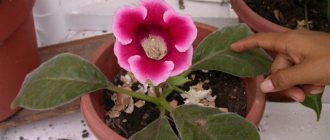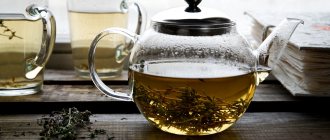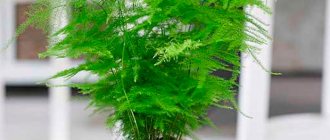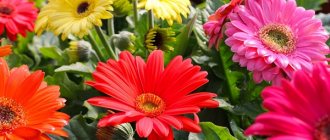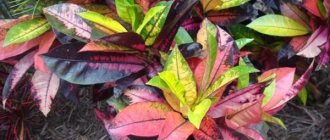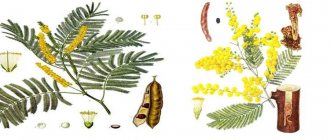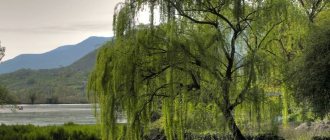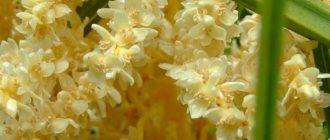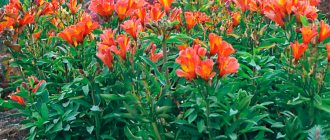If you evaluate freesia (photo), it is difficult not to notice how elegant and refined its flowers look. Even today they are considered a sign of refined taste. The color and variety of the exotic do not affect its honorary title - a symbol of high society.
Freesia is not distinguished by lush sprouts of greenery, but it pleases flower growers with truly exquisite flowers. This plant occupies a special place not only among home lovers, it is very popular among florists due to the presence of exquisite flowers.
When added to bouquets, you can get stunning compositions that are distinguished by elegance.

The aroma of freesia is also valuable. It is so gentle and pleasant that it has long occupied a special niche among perfumers. The smell of the flower is somewhat similar to the forest lily of the valley, but not so bright and cloying. This similarity made it possible to give the beauty a middle name – Cape lily of the valley.
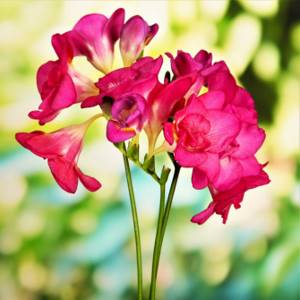
Freesia - a fragrant beauty
She came to us from distant Africa, to be more precise, from its southern part. During the active colonization of the continent, various valuable things, including plants, were exported from there.
The royals of France and Foggy Albion were the first to appreciate the beauty of the exotic guest. And only centuries later it became widely available to any connoisseur of beauty.
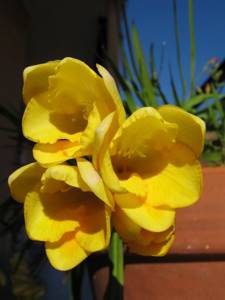
The use of freesia in garden design
Freesia has become widespread in the field of aromatherapy and perfumery. The culture perfectly reduces fatigue, prevents headaches and depression.
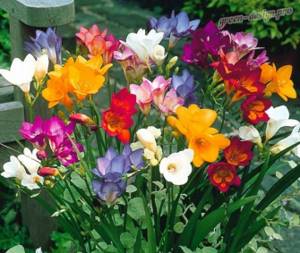
In landscape design, the plant perfectly complements mixborders. Freesia's companions are:
- thyme;
- lavender;
- rosemary;
- clean.
The flower looks beautiful in pots for patio decoration. The latest trend in landscape design is the use of plants to decorate lawns, rock gardens and rocky gardens.
Types and varieties
The types and varieties of freesia are very diverse. A huge number of them were bred through selective breeding, to the delight of florists and flower growers.
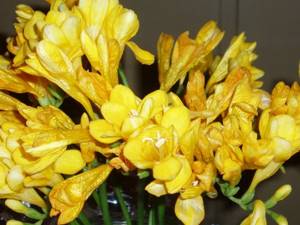
All of them belong to the Iris family. They are a bulbous plant, but can also reproduce by seeds, which are set as a result of flowering.
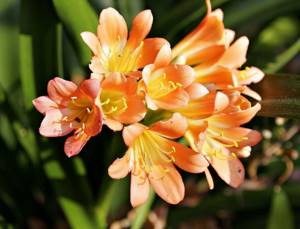
If we go into the description of each individual variety, it can take a lot of time. Their diversity is expressed in a huge range of color colors.
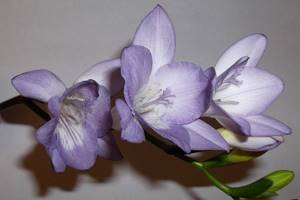
Differences are also observed in the appearance of the stems and buds. The petals of the cups are simple, double and semi-double.

Popular varieties
Each type of freesia is good in its own way. The most popular are 3 varieties. If it’s hard to decide, you can buy a mix of different types as a set.
Armstrong's (Freesia armstrongii)
This is the most famous plant variety. The flowers are brightly colored and have a distinct scent. The white bell buds have orange spots at the base, and the perianths are purple-pink. There are varieties with red, purple or blue petals. Maximum height 65 cm, bud diameter 5 cm.
Alba (Freesia refracta var. alba)
Freesia Alba has a spikelet that splits during flowering. The inflorescence consists of 10 snow-white flowers. The petals are corrugated with a smooth transition to yellow at the base.
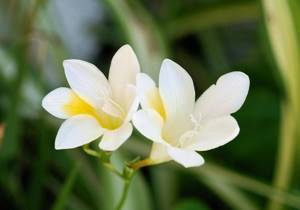
Alba in flowering period
Unlike other varieties, Alba does not have a pronounced odor.
Maximum height 35 cm, bud diameter 7 cm.
Fragrant (Freesia refracta odorata)
From the name it is easy to guess that the flower has a rich aroma. Fragrant has the smell of lily of the valley. The inflorescence consists of 6-8 bright yellow buds with orange spots at the bottom. Flowers in the shape of a narrowed tube. Bushes of medium density with an even thin stem.
We grow in open ground
Growing is possible both at home and outdoors. Those who once planted the bulbs of an exotic beauty on the street repeat the operation annually.
With a little preparation, planting tubers is not difficult, but you should take into account the conditions for the plant's growth.
This color likes the daylight hours to be long.
The sun is vital for it, but without direct rays, which easily burn the delicate petals. It is also worth protecting the stems from the wind. With strong gusts, they will simply break the fragile sprouts.
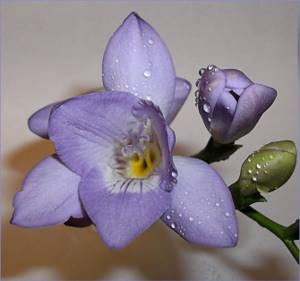
Rules for caring for freesia
Freesia flowering lasts for 30-45 days. To prolong flowering, you will need to trim 1/3 of the stem. The culture responds very well to fertilizing. For this, superphosphate is used (30 g of substance per 10 liters of water) and potassium salt. A prerequisite is to constantly moisten the soil, but not to over-moisten it.
Twice a season the crop is sprayed with a soap solution. This is necessary as a preventive measure against the occurrence of spider mites and aphids. If rot is detected on the leaves of the plant, it is treated with potassium permanganate diluted with water and foundationazole.
Optimal soil composition
You can get healthy flowering bunches if you take into account important tips for choosing soil. When planting tubers outdoors, you should choose soil that has neutral acidity; an option with a slightly acidic environment is also suitable.
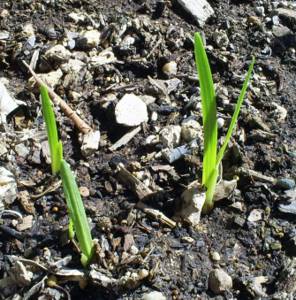
If the soil’s parameters do not meet the requirements, it can be diluted with sand or peat.
Remember to fertilize poor soil. Organic substances and mineral granules should be added to it.
Time for planting in soil
Cape lily of the valley is absolutely not frost-resistant. You can plant bulbs only after warmth has firmly reigned outside, and the return of cold weather is not predicted. Light frosts can destroy sprouts that have already sprouted.
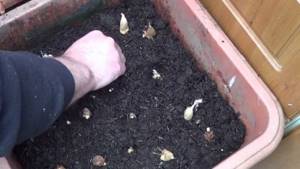
Tubers are planted in May - early June, if we are talking about central Russia. In other climatic zones, you should focus on the unique features of weather conditions.
If we are talking about the northern regions of the country, then plants already grown in the apartment should be planted in the ground.
Features of freesia
Freesia has a persistent, pleasant scent; it is called “Cape lily of the valley.” The tubers of the plant are represented by an atypically shaped bulb with light brown or white scales; they are renewed every second season (the bulb dies and a new root appears). The leaves are thin, linear, elongated, with a vein in the middle, 15-20 cm long, 1.5 cm wide. They grow directly from the ground.
One-sided inflorescence with a narrow tube, widened at the base and 3-6 flowers of different shades. There are cream, purple, pink, blue, white, orange. In mid-August they bloom and delight with their appearance until frost. Branched and smooth stem 20-70 cm high. The fruit is a capsule.
Features of freesia:
- It has different aromas: citrus, lily of the valley, fresh grass.
- It lasts up to 10 days when cut, remaining fresh and fragrant.
- Florists make a bridal bouquet from it.
- Used to create perfume.
- The yellow-red variety grows the fastest.
- Popular with landscape designers, creating a beautiful look in flower beds and gardens.
Freesia can be successfully grown at the dacha, in a greenhouse, a greenhouse, or a room.
Care
Street beauties require special care. The grower will have to take care of the exotic flower every day in order to get beautiful and even buds of different shades.
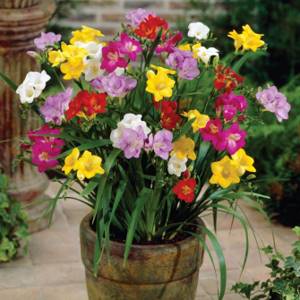
Outdoor care is characterized by the following features:
- Regular watering, which should begin after the first shoots appear. Water for irrigation should be warm. You should avoid getting moisture on the stems, and especially on the buds.
- Loosening the soil. This allows even penetration of water and air and promotes active growth.
- Removing weeds.
- Regular feeding.
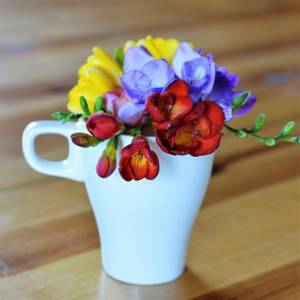
You cannot do without special supports that will prevent damage to the stems in the wind.
Confident caring for freesia at home (with photo)
Potted room conditions are suitable for growing decorative flowers, and confident freesia care at home does not require much effort. Bright green leaves with pointed ends add attractiveness to flower arrangements, and the height of a green pet in an apartment can reach fifty centimeters. The colors of double, semi-double and non-double flowers can be very different - from snow-white to confident purple. The most common are white freesia and colorful, unrivaled red freesia.
Look at the photo of freesia flowers grown at home:
Proper organization of care allows for active growth and abundant color of a decorative representative of the plant world. The basic rules for keeping this exotic plant are the following criteria:
- The temperature should range from 20 to 25 degrees Celsius for young shoots. Older individuals are kept in temperature conditions with heat indicators from 15 to 18 degrees.
- The lighting can be quite bright without shading. It is desirable to place the flower on the south side of the house, with intense light during a 12-hour interval. Artificial lighting is created using fluorescent lamps, which is especially important in winter.
- Watering during germination of the bulbs should be moderate, the rest of the time – abundantly. It is especially important to water properly during flowering.
- Air humidity should be average; in hot weather, the flower needs regular spraying.
- The plant needs nutritious and loose soil. The best option would be a mixture of peat, river sand and turf soil in a ratio of 2:1:0.5. The second option is leaf soil, humus and peat in equal parts. You can purchase a ready-made substrate for the leafy bulbous subspecies.
- Fertilizing can be done every two weeks using a weak solution of mineral fertilizer. Fertilizers can be applied immediately after the first shoots appear. Active growth, budding and flowering time require additional feeding with mineral complex preparations. They are usually added in accordance with the instructions.
- Reproduction is carried out using seeds, corms or tubers.
After the flowering period is over, the dry peduncle is cut off and watering is reduced. The bulbs are kept in the ground under conditions of good lighting, fairly warm temperatures, and infrequent watering. The dormant period ends after about two to three months, after which new bulbs form. It is worth remembering that, unlike many other ornamental plants, freesia bulbs cannot be stored in the refrigerator.
Growing freesia at home
The fastidiousness of freesia means that growing it outside is not very convenient. It is much easier to grow a tuber in a pot. It is much easier to maintain ideal temperature and humidity indoors than outdoors.
When planting at home, you should remember several important rules:
- The pot should be small in diameter, about 20-25 cm.
- When preparing the soil, it is important not to forget about laying drainage and lightly moistening the nutrient mixture
- The bulbs are planted shallowly - 2-3 cm.
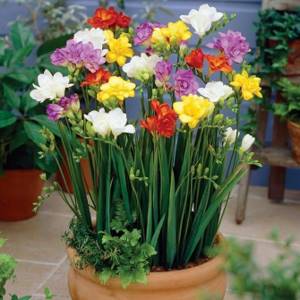
The pot should be kept in a cool place until the first sprouts appear.
Optimal care conditions
You can get a beautiful and lush living bouquet if you follow a number of mandatory recommendations. In particular, it is important to strictly adhere to the correct temperature and humidity conditions.
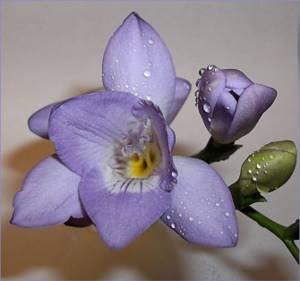
The pot is placed on a windowsill where there is enough light, but there are no direct scorching rays of the sun. The plant requires regular moisture, but it is extremely important not to overdo it with watering. Excessive amounts of water can cause tubers to rot.
Experienced flower growers have their own secrets on how to achieve perfect flowering. They recommend placing plants near home fountains or humidifiers.
Picturesque landscape in the fresh air - planting freesia in the ground
Pretentious, original flowers can create a picturesque picture on the site or in the yard. When planting freesia in the ground, you must follow certain rules that will help you grow entire meadows and flower beds of this colorful representative of the flora. Getting a scenic outdoor scenery is quite easy. Planting freesia in open ground is not particularly difficult.
The planting site should be slightly shaded, well protected from wind and drafts. Direct planting is carried out no earlier than the end of May, when the likelihood of renewed frosts is minimized. The earth during this period should warm up to 10-13 degrees.
Properly growing and caring for freesia in open ground is not a very labor-intensive process if everything is done confidently and step by step. Before planting, the bulbs are kept in a weak solution of potassium permanganate for about half an hour. In a moist area with nutritious, loose soil, grates or pegs are installed for subsequent garter. Then the bulbs are dug in to different depths - this mainly depends on the type of soil: for heavy soil the depth can be approximately 6 cm, for medium soil - 8-10 cm, for light soil - up to 12 cm. Planting differs in similar conditions for growing freesia and care requirements floral elements in a greenhouse or greenhouse.
It is recommended to feed young shoots using two grams of saltpeter diluted with one liter of water. And already adult plants can be fertilized twice with potassium salt and superphosphate solution over the summer. Salt is diluted in an amount of approximately 20 g per 10 liters of water, and superphosphate - in a ratio of 20-30 g per the same volume of water. Freesia blooms for one and a half months, equally original, appearing as single pictures or as part of other representatives of decorative plantings.
Features of caring for bulbs
There are also some peculiarities in the separate care of bulbs. They must be removed from the soil annually and subjected to special treatment in order to obtain good flowering in the future.
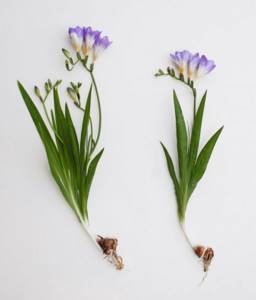
When growing outdoors, the root part should be dug up in the fall. If we are talking about home flowers, then it all depends on the wishes of the amateur himself.
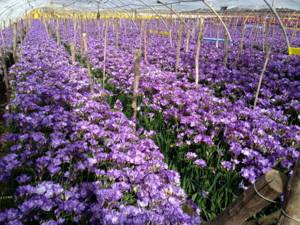
The extracted tubers should be stored in rooms with a temperature of 22˚ to 26˚C. They like fairly high humidity, but don't worry about them germinating prematurely.
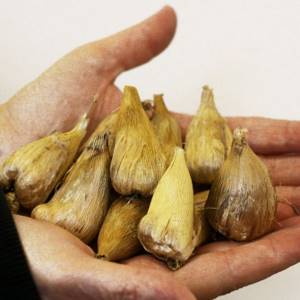
If the planting material lies in separate dry boxes or nets, it will remain intact until the time of planting.
Unique and varied freesia flower
In the Iris family, there are 19 species of freesia flowers, each of which is distinguished by individual hybrid varieties and has undeniable advantages. The unique and varied color of the petals of the freesia flower decorates many areas. Breeders and botanists are working to breed the following species.
Among the newly bred varieties one can highlight the tall Juno with large double flowers, the 80-centimeter Sunny Beach with inflorescences of 8-10 single flowers, and the tall semi-double Cinderella. The tall Lada has a stable peduncle and 10-flowered inflorescences, while the tall original Chaika has a pleasant weak aroma and early flowering period.
Rose Freesia receives special attention - a beautiful plant with large double flowers and a pronounced, unobtrusive aroma. Attractive, amazingly shaped flowers are abundantly covered with upright, compact shrubs. Flowering continues throughout the season, and the bright golden yellow color remains powerful and rich throughout. Even in a photo, the color of this type of freesia can be conveyed in all its colorfulness and sophistication.

